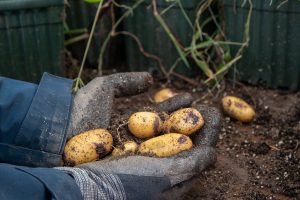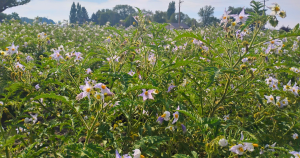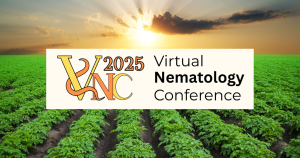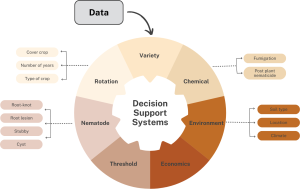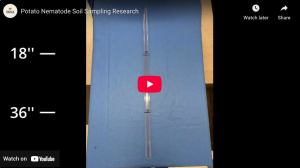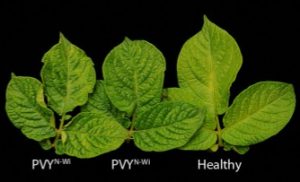Nematode Research Helping Potato Farmers – UI CALS Newsletter
The University of Idaho College of Agriculture and Life Sciences featured PAPAS in its “Catching Up with CALS” newsletter (Dec. 21, 2022). Learn more about PAPAS in this article, re-printed with permission from UI CALS.
Nematode Research Helping Potato Farmers
A University of Idaho-led research team has received a $6.8 million U.S. Department of Agriculture award to develop new diagnostic tools, management practices and resources for controlling harmful nematodes in potato fields.
The four-year project is funded through the USDA National Institute of Food and Agriculture’s Specialty Crop Research Initiative. The project’s goals include developing support models to guide growers’ management decisions, identifying molecular assays to differentiate nematode pathotypes, developing resistant potato varieties and creating a “smart chemical” for nematode-specific control.
Louise-Marie Dandurand, with U of I’s Department of Entomology, Plant Pathology and Nematology, heads the project, titled “PAPAS: Potatoes and Pests, Actionable Science Against Nematodes.”
Nematodes are tiny roundworms with unsegmented bodies. Most nematodes are beneficial to soil, but plant-parasitic nematodes attack plant roots and may kill entire plants.
The project was backed by more than 70 letters of support from packers, processors, farmers, regulators and large agricultural businesses.
“You have to have a large amount of industry support for your proposal,” Dandurand said.
Joseph Kuhl, with U of I’s Department of Plant Sciences, and Philip Watson, with U of I’s Department of Agricultural Economics and Rural Sociology, are co-project directors, along with researchers from Michigan State University, Washington State University and USDA’s Agricultural Research Service.
U of I researchers Allan Caplan, Fangming Xiao and Rhett Spear are among the principal investigators. Researchers from Washington State University, Cornell University, Oregon State University, Michigan State University, University of Wisconsin and USDA-ARS are also participating.
The researchers will target two species of potato cyst nematodes — the pale cyst nematode, which is known in the U.S. to exist only in a small area of eastern Idaho, and the golden nematode, found in New York. Potato cyst nematodes, which produce cysts harboring eggs that can remain viable for decades in the absence of a host, are especially concerning to the industry and keeping them from spreading is vital for trade.
“Potato cyst nematodes are an internationally regulated pest,” Dandurand said. “If an infestation gets out of hand, there’s an 80% yield-reduction potential.”
The team will also evaluate other nematodes important to the industry such as the Columbia and northern root-knot nematodes.
There’s been little research to date on nematode population thresholds that warrant fumigation. Having the ability to identify nematodes by pathotype or race would allow potato farmers to select appropriate resistant varieties to plant. The researchers are seeking to identify a gene responsible for nematode resistance within litchi tomato, which is a plant in the nightshade family known to stimulate nematode cysts to hatch in the absence of a viable host. Potato breeders would then introduce the trait into popular potato varieties using biotechnology. Conventional breeding efforts to develop resistant varieties are also underway.
“We have made quite a bit of progress toward introducing resistance through traditional breeding methods,” Dandurand said.
Researchers have developed potato varieties with up to 50% resistance to nematodes. The project aims to significantly boost the resistance level by producing varieties that incorporate multiple resistance genes.
The researchers suspect litchi tomato contains a chemical that is highly toxic to nematodes. Another aspect of their project entails identifying that chemical and using it as a nematicide that likely wouldn’t harm beneficial nematodes and insects.
Dandurand and her team will evaluate how crop rotations involving resistant potato varieties affect nematode populations. The researchers will conduct their trials in infested commercial fields. They will use nematode-infested soil in 50-gallon steel tanks and 5-gallon buckets placed within an infested field to determine the best rotation to reduce the nematode populations. Nematodes will be constrained by nylon mesh sacks, and irrigation water will be filtered to prevent escapes. Work on golden nematodes will be conducted in trial fields already set up for nematode research in New York.
To help the industry implement their findings, they’ll host workshops in the grant’s third year to provide training on diagnostic methods to determine the race or pathotype of a nematode species, and to educate farmers about resistant varieties and rotations. In the fourth year, they’ll also host workshops teaching farmers how to use predictive models and diagnostic tools to guide management decisions.


